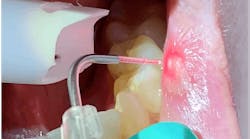New fiber-reinforced composite material offers advancements in oral implants
Journal of Oral Implantology — New materials and new technologies offer opportunities to bring implant dentistry to more patients. Fiber-reinforced composite is a new material that promises advantages for use in oral and craniofacial applications as well as in orthopedics. Discovering how it responds to stress and strain can help gauge its usefulness.
As part of a special issue of the Journal of Oral Implantology focusing on anticipated advances in oral surgery, a new study compares fiber-reinforced composite and titanium implants. Researchers analyzed how the two materials affect stress and strain on the implant and the bone tissue surrounding it. They also compared interfacial stresses between the materials under three directions of load.
Distribution of stress and strain to the jawbone is significantly changed after reconstruction with oral implants. How an implant using fiber-reinforced composite reacts has not yet been well tested. This biomechanical connection between implant and bone can be different for each patient and is hard to measure.
Therefore, this study used a three-dimensional finite element model constructed from a mandibular bone and an implant to test these materials. The model was subjected to stress loads of 50 N (Newton) in vertical and horizontal directions.
Although variances were observed for both the fiber-reinforced composite and the titanium materials with these tests, the composite performed well. The strain distribution demonstrated a clear difference between the two materials. The results show that the vertical load stress range of the fiber-reinforced composite implant was close to the stress level for optimal bone growth. The composite implant also proved to have a more even distribution of stress at the bone surrounding the implant than the titanium.
While new technologies do not always mean new methodologies, they do offer additional choices in how dentists care for patients. More choices in implant dentistry can bring restorative techniques to a wider variety of patients, and advancing patient care remains the primary focus.
Full text of the article, “Stress and Strain Analysis of the Bone-Implant Interface: A Comparison of Fiber-Reinforced Composite and Titanium Implants Utilizing 3-Dimensional Finite Element Study," Journal of Oral Implantology, Vol. 37, Special Issue, 2011, is available by clicking here.
The Journal of Oral Implantology is the official publication of the American Academy of Implant Dentistry and of the American Academy of Implant Prosthodontics. It is dedicated to providing valuable information to general dentists, oral surgeons, prosthodontists, periodontists, scientists, clinicians, laboratory owners and technicians, manufacturers, and educators. The JOI distinguishes itself as the first and oldest journal in the world devoted exclusively to implant dentistry. For more information, click here.





